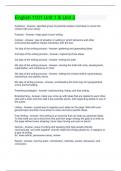English 1101 Unit 1 & Unit 2
Audience - Answer- specified group of potential readers most likely to come into
contact with your essay.
Purpose - Answer- major goal of your writing.
Context - Answer- type of situation or setting in which behaviors and other
environmental patterns impact interaction with the text.
1st step of the writing process - Answer- gathering and generating ideas.
2nd step of the writing process - Answer- organizing those ideas.
3rd step of the writing process - Answer- writing the draft.
4th step of the writing process - Answer- revising the draft with unity, development,
organization, and coherence in mind.
5th step of the writing process - Answer- editing the revised draft for grammatical,
mechanical, and stylistic errors.
6th step of writing process - Answer- proofreading the final copy for typographical
errors and formatting.
Prewriting strategies - Answer- brainstorming, listing, and free writing.
Brainstorming - Answer- helps you come up with ideas that are related to each other,
start with a topic and then add a few possible points, add supporting details to one of
the points.
Listing - Answer- a good way to organize your ideas on the page. Start with your
general topic and then move down to more and more specific ideas.
Free Writing - Answer- free writing is an exercise that can help you generate ideas.
To free write you set a short time limit and then begin writing; the goal is to write on
the page without every stopping; never step moving your pen or pencil.
Genres - Answer- ways of writing and speaking that help people interact,
communicate, and work together. Genres reflect the things people do. A category or
a type of writing.
Ex: news article, persuasive essay, review.
Report - Answer- has five parts...introduction, methods, results, discussion, and
conclusion.
, Local Concerns - Answer- relate to word-level and sentence-level issues. These
include diction, coordination, subordination, sentence variety, emphasis, and
parallelism.
Substantive Concerns - Answer- relate to matter of thought. Depth of ideas,
originality, insight, logic, ethos, pathos, logos, inductive reasoning, deductive
reasoning (and the related criteria for both), logical fallacies, appeal to authority,
semantic appeal, statistical appeal, and more.
Coherence - Answer- Transitional Phrases, Repetition of keywords, Use of
Synonyms, Effective use of pronouns, Use of parallelism.
Five Paragraph Essay - Answer- Intro, Thesis Statement, Three Body Paragraph
(topic sentence and specific development for each), Conclusion
Development - Answer- Examples: facts, specifics, concrete details, statistics,
particular cases, etc.
Abstract vs Concrete
(animals)
Unity - Answer- the principle that all elements of an essay must support a single
overall idea.
Thesis Statement
Topic Sentence
Rhetoric - Answer- using language effectively to persuade, inform, educate, or
entertain.
Rhetorical Situation - Answer- the circumstances in which you communicate.
Topic - Answer- what you will write about.
Context - Answer- known as the "situation" which generates the need to writing.
Rhetorical Device - Answer- is a technique that an author uses with the goal of
persuading the reader or listener to consider a topic from a different perspective,
take the writer or readers position, or even take action.
Rhetorical Question - Answer- A question asked merely for rhetorical effect and not
requiring an answer
Allusion - Answer- A brief and indirect reference to a person, place, thing or idea of
historical, cultural, literary or political significance.
Repetition - Answer- repeats a word or phrase several times to make an idea clearer
or for emphasis.
Parallel Structure - Answer- uses words or phrases that are not identical but have
the same grammatical structure.




